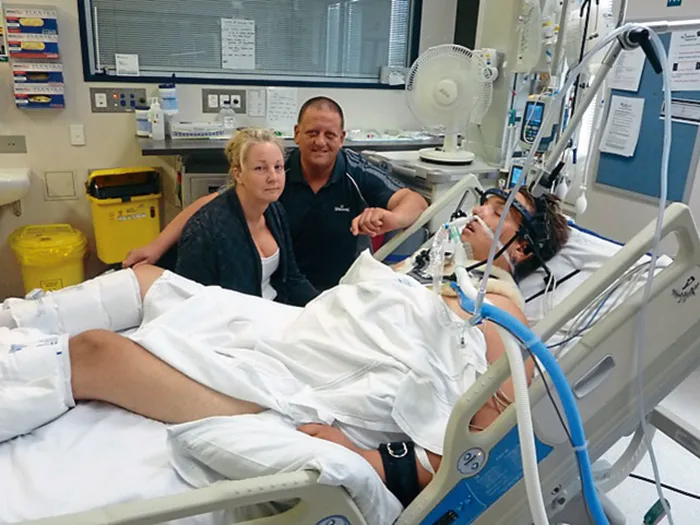It’s hard to imagine that behind an idyllic portrait of rural Australia lurks the worst drug problem this country has ever experienced. Crystal methamphetamine has taken a vice-like grip on the picturesque Goulburn Valley, in northern Victoria, along with much of the rest of rural Australia. So grave is the situation that the Australian Crime Commission has publicly warned that we’re now in the midst of an ice “pandemic”.
Growing up, Christopher Smith was a knockabout country boy who loved to go fishing, hunting and camping with his family. Bright and extroverted with a ready grin, he was popular among his peers and did well at the local private grammar school.
Yet within 18 months of his graduation, he was transformed into an unpredictable drug user with a chronic ice addiction that would nearly kill him.
His parents, Elizabeth and Darren, gave Chris and his younger sister, Claudia, a stable and loving upbringing in the pretty agricultural town of Numurkah, just north of Shepparton. When they discovered Chris had been drinking in Year 9, they moved to Darwin for a year in an attempt to steer him back onto a more wholesome path and spend quality time outdoors as a family.
Yet, back home, when he was 18 and in the first year of his electrician’s apprenticeship, Chris made the worst decision of his life. While out drinking at a bar, a mate asked him if he wanted a smoke of his pipe.
“I didn’t know what he was talking about,” Chris says. “We went to the disabled toilet cubicle and he pulled out this [ice] pipe.”
The ensuing high – in which his brain was flooded with the feel-good chemical dopamine – was the best Chris would experience, although he’d spend the next 18 months trying to replicate it. “It’s like a really strong sense of vertigo at first,” he says. “You feel indestructible, 10-feet tall and bulletproof. It heightens your senses. And you’re having the best time.”
Resembling crushed ice or sea salt, crystal methamphetamine is usually smoked, injected or snorted. It works by speeding up the function of the brain and nervous system, making users aroused, exhilarated and alert. It’s more refined than related amphetamine-type drugs, such as speed and ecstasy, which are usually cut or mixed with other substances. In the past five years, the purity of ice being sold on Australian streets has skyrocketed from an average of about 5-15 per cent to between 50 and 80 per cent (in some places, it’s reportedly reached 90 per cent).
In this case, increased purity is not a good thing. It makes the drug more powerful, addictive and harmful to the body, with stronger side-effects and a higher risk of mental health problems, such as psychosis. After the artificial euphoria has worn off, users often feel weepy, depressed and anxious.
“I could never stand the ice comedowns,” says fast-talking reformed drug user Jimmy, who used cannabis and prescription tranquillisers to combat the effects. “They were the worst.”
Furthermore, with prolonged use of ice, feel-good receptors in the brain become damaged, making it impossible for users to feel happy – or even normal – without ice.
As tolerance increases, they need ever-increasing amounts of the drug to have any effect. Like Chris, many get sucked into a cycle of dependency.
“You tell yourself you have it under control,” he says. “But you don’t. In six to 12 months, I went from using it on weekends to a $400-a-day habit. It sucked the life out of me.”

Darren and Elizabeth Smith suffered the trauma of seeing their son develop an ice addiction

Darren and Elizabeth with their son, Chris, in hospital.
Dr Sharman Stone, the kind-eyed federal MP for Murray, has become all too familiar with the fallout of ice abuse. People in her constituency, like those in many other rural areas, are doing it tough and have been hit by drought, bushfires and floods. Teenagers complain of being isolated by a lack of public transport. Worried parents are among those coming into Dr Stone’s office seeking advice.
“Young people are combining ice with alcohol,” says Dr Stone. “They pre-load at home and go to the bar half-tanked on cheap alcohol so they save money. The saving grace with alcohol on its own is that you fall over and stop yourself causing harm to yourself or anyone else. But when you add ice, you become Superman or Superwoman – and a nightmare for police.”
This supercharged sensation is one of the reasons ice can be so dangerous. Because users feel alert and invincible, they’ll hop in a car and drive even if they’ve drunk enough to render most people unconscious, putting everyone on the road at risk. They can go for days without eating, drinking or sleeping. Some use it as a libido-enhancer to fuel marathon sex sessions, or as an appetite suppressant. Or they may work, study, party or do housework right through the night. In short, they have no off switch.
That’s only the immediate effects.
Continuing use of ice can result in hallucinations, paranoia and psychosis. Users may turn on loved ones, convinced they’re secretly plotting against them, and are more likely to commit crimes. Ice can rob people of their empathy, making ordinarily gentle and kind people capable of acts of extreme depravity. In Victoria alone, a person is killed nearly every month by someone affected by ice.
Take the cases of Kara Doyle, 24, who was shot dead by her boyfriend last year, or the sickening murder of a 10-month-old baby in his cot at the hands of an ice-addled burglar in 2012. In a notorious Sydney case, finance company director Brendan Francis McMahon, who admitted to taking ice every day to give him a “mental push” at work, was jailed in 2006 for torturing and mutilating 17 rabbits and a guinea pig. The animals’ corpses, some skinned, were found abandoned in a laneway near his CBD office.
Then there are the ripple effects.
Youth worker Les Twentyman describes the plight of young children with posttraumatic stress from witnessing their ice-addicted parents’ violence.
“These kids don’t go to school because their parents don’t know what time or day it is,” he says. “They end up on the streets. This is really a national crisis.”
Indeed, some health workers privately look back on Australia’s heroin problem of the 1980s and 1990s as “the good old days” compared to today’s ice scourge.
“At least with heroin, they were passive and only harming themselves,” says one. “With ice, they’re a threat to everyone.”
On a cold Wednesday evening in mid-May, The Weekly joined more than 200 locals attending a drugs forum at a school hall in the town of Kyabram, about 40 kilometres west of Shepparton. Mother-of-seven Leonie, 52, a medical receptionist, took to the stage to give a heartbreaking account of her living hell at seeing her two eldest boys destroyed by ice.
Michael, 19, was in a secure psychiatric facility with “no life in his eyes and no memory”, she said, while former scholarship student Andrew, 22, was in rehab and “knows what he has lost and what he has done when he was using – and that eats him up.
“My younger children have seensome terrible things: their brothers taken out of the house in handcuffs, peppersprayed, and all the doors in the house broken,” said Leonie, who had no idea what ice was when she first found some in Andy’s backpack. “I’ve seen my 17-year-old cry next to his brother’s bed and beg him to come home and get better. It’s been like a war zone for them for a very long time now … and we grieve for the loss of the boys every day.”
Michael and Andrew, who were both talented footballers, began taking marijuana and ice after falling in with the wrong crowd. Leonie tried everything to get them off it – including locking them in the house – but to no avail. She accepts Michael is irrevocably damaged and will never be the same again.
“You have got to find your joy in friends, music and sport,” she tells the drugs forum. “Not drugs.”
Also speaking at the event was Jim O’Brien, the former officer in charge of the Victorian Police task force that blew apart major underworld crime networks and secured the arrest of drug king-pin Tony Mokbel in a plot immortalised by the Nine Network’s Underbelly series. Methamphetamine, he tells the audience authoritatively, has become Australia’s “drug of choice”.
It seems parents in Kyabram have reason to worry. Here, as in the rest of country Victoria, traditional debutante balls are followed by wild after-parties, often held out in warehouses or sheds, far away from parents and teachers. At a recent party, The Weekly has learned, a dealer known as The Candyman arrived out the front to sell teens a range of drugs, including ice. Dr Stone, the local MP, says these parties are known to descend into “drug-fuelled orgies”.
Ice isn’t hard to get.
Early findings from a national survey last year reveal almost 90 per cent of users say ice is easy or very easy to obtain. Indeed, within hours of arriving in Shepparton,
The Weekly knew exactly where it could be purchased. For young people, it often works out cheaper than a night’s worth of drinks from a bar or club. The price for enough ice for a pipe to keep a user high for a night is around $100 (although this varies, with the highest prices seen in the Northern Territory). It also provides a surge in confidence at a time when many are grappling with stress, anxiety and finding their way in the world. Unlike cocaine and heroin, which rely on overseas crops, much of the ice used in Australia is manufactured locally in clandestine laboratories and the ingredients can be bought easily at hardware stores and pharmacies.
It’s no wonder, then, that the number of ambulance call-outs to ice-related incidents in country Victoria has tripled in a year.
For the first time, paramedics now fear for their safety.
“People who have taken ice can be very aggressive,” says Michael Whelan, a mobile intensive care ambulance team manager in Shepparton. “Paramedics don’t have any self-protection – we have blue shirts and a big white van – so we really depend on police as our security service.”
Problem is, it can take up to three paramedics and six police officers to get one raging ice user under control, Mr Whelan says, which takes much of a town’s emergency services force off the road.
“If you have got other things going on, it’s impossible,” he says.
Sedating them is another challenge: very high doses are needed to have any impact. It was a near-fatal accident that eventually saved Chris Smith from ice. Shortly after a nightmare week in which he lost his job, driver’s licence and 69-year-old grandfather in a fall from a ladder, he dived into shallow water in the Murray River and broke his neck in two places. While under the anxious watch of his parents in intensive care, Chris went into severe detox.
“He started to require such high amounts of sedatives that he was about to go into renal failure,” his mum, Elizabeth, recalls. “There was talk of dialysis.”
Chris spent the next six months in a halo traction, feeling low and depressed as he endured both ice withdrawal and a slow physical recovery.
“If I hadn’t been stuck at home the way I was, I probably would have gone out and been doing ice again,” he admits. After that, however, friends and family began to notice signs of his old self returning at last.
The infamous Faces of Meth campaign, in which US police mug shots show the horrifying descent of normal people into haggard, sunken-faced addicts with rotten teeth, has shocked people around the word.
A particularly gruesome side-effect of heavy use of ice is “meth mouth”, which leads teeth to decay, crack and fall out of the skull. Skin lesions often develop from users’ excessive scratching at “crank bugs”, an imagined sensation of bugs crawling under their skin and biting them.
“[Ice] might be good for weight loss,” remarks ex-detective Jim O’Brien wryly in his presentation at the drugs forum in Kyabram. “But it doesn’t do a whole lot for your looks.”
Some people who take ice, however, can remain functional. Lisa*, 50, an aged care worker from Sydney, used to take it recreationally with an ex-partner.
“I honestly don’t believe it’s as bad as people make out,” she says. “I wasn’t taking huge amounts, but it would last me the night. It made me hyperactive – I wanted to clean non-stop, for example.”
So how would you know if your child or someone you know is taking ice?
Surprisingly, it might not be obvious. They won’t slur their words or become uncoordinated like drunk people. They won’t be spaced out, red-eyed or carry the tell-tale odour of cannabis (ice doesn’t give off a smell).
More likely, they will be very alert and hyper-focused, with dilated pupils. They might become very talkative, twitchy or develop a tremor. Physically, their heart rate and breathing will quicken, and they’ll sweat more than normal. And while users feel more intelligent, perceptive and insightful, they can also become absorbed in mundane and repetitive tasks for extended periods. Because they have no appetite, they may lose a lot of weight in a short space of time.

Chris Smith was a picture of happiness and innocence as a boy.
When Chris first moved out of home and into a house with friends, his mother, Elizabeth, was upset when she discovered he was smoking marijuana. Yet she didn’t find out about his ice habit until, concerned by his erratic behaviour, she found drug paraphernalia among his belongings.
“You can cover it up,” Chris says. “You can still be around people and they wouldn’t know.”
And for young people, he says, there’s no stigma around ice.
“It’s not seen as a big deal. It’s well accepted – you smoke a pipe? So what?”
Asked where he’d be today if he hadn’t had his accident, he says, “in jail or dead”. Yet three years on, Chris has turned his life around. He made a fresh start last year by moving to Queensland to do a degree in environmental science. And he phones his parents every day. “I’m very lucky to have my family,” the 23-year-old says. “I couldn’t have done it without them.”
Chris Dawson, CEO of the Australian Crime Commission, is not a scaremonger. His organisation is all about gathering solid evidence and preparing carefully worded reports. Yet he doesn’t hold back when it comes to ice.
“It’s such an insidious drug,” he says. “And it doesn’t discriminate – it pervades all levels of our nation. So you shouldn’t sit back and read an article like this and think, ‘This couldn’t happen to me or a member of my family’. It can happen to anyone.”
- Name has been changed.



